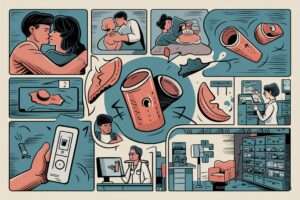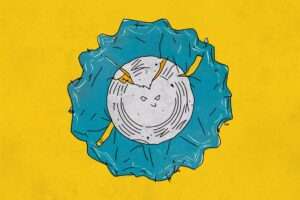What to Do When a Condom Breaks: A Comprehensive Guide
Condoms are one of the most effective methods for preventing both unwanted pregnancies and sexually transmitted infections (STIs). However, even when used correctly, condoms can sometimes break or slip off during sexual activity. If you’ve ever experienced a condom breaking, you know it can be a stressful and anxiety-inducing situation.
Don’t worry – we’ve got you covered with this comprehensive guide on what to do when a condom breaks, how to prevent it from happening, and what steps to take to protect your sexual health.
Condoms and STDs: Understanding Protection and Limitations

Table of Contents
ToggleUnderstanding Condom Breakage
Before we dive into what to do when a condom breaks, it’s important to understand why it happens and how often it occurs.
Giardiasis: Understanding, Preventing and Treating the “Beaver Fever”
How Often Do Condoms Break?
Condom breakage is relatively rare when used correctly. According to a study published in the journal Contraception, the breakage rate for male condoms is about 1-4% during vaginal intercourse. However, this rate can increase if condoms are used incorrectly or are past their expiration date.
Pubic Lice (Crabs): Symptoms, Diagnosis and Treatment

Common Causes of Condom Breakage
1. Incorrect size: Using a condom that’s too small or too large can increase the risk of breakage.
2. Improper storage: Exposure to heat, sunlight, or sharp objects can weaken condoms.
3. Expired condoms: Using condoms past their expiration date increases the risk of breakage.
4. Insufficient lubrication: Lack of lubrication can cause increased friction and potential breakage.
5. Using oil-based lubricants with latex condoms: Oil-based products can degrade latex, leading to breakage.
6. Double-bagging: Using two condoms at once increases friction and the likelihood of breakage.
Is Scabies an STD? Understanding the Facts About This Contagious Skin Condition

Immediate Steps to Take When a Condom Breaks
If you notice a condom has broken during sexual activity, don’t panic. Here are the immediate steps you should take:
1. Stop Sexual Activity Immediately
As soon as you notice the condom has broken, stop all sexual activity. This helps minimize the risk of further exposure to bodily fluids.

2. Carefully Remove the Broken Condom
Gently remove the broken condom, being careful not to spill any semen. If possible, urinate to help flush out any potential contaminants from the urethra.
How Long Does It Take for Chlamydia to Show Up? Understanding the Timeline and Symptoms
3. Clean the Genital Area
Wash the genital area thoroughly with mild soap and warm water. This can help remove any visible fluids, but keep in mind that it doesn’t eliminate the risk of STIs or pregnancy.
4. Assess the Situation
Try to determine when the condom broke during intercourse. This information can be helpful when discussing the situation with a healthcare provider.
5. Discuss the Situation with Your Partner
Open communication is crucial. Discuss the situation calmly with your partner and decide on the next steps together.
Trichomoniasis: Understanding, Preventing and Treating this Common STI

Long-Term Steps and Considerations
After taking immediate action, there are several important long-term steps to consider:
1. Emergency Contraception
If pregnancy is a concern, consider emergency contraception. There are several options available:
– Plan B (levonorgestrel): Available over-the-counter and most effective when taken within 72 hours of unprotected sex.
– Ella (ulipristal acetate): Prescription-only and effective up to 5 days after unprotected sex.
– Copper IUD: Can be inserted up to 5 days after unprotected sex and provides ongoing contraception.
According to the World Health Organization, emergency contraceptive pills can reduce the risk of pregnancy by up to 95% when taken within the first 24 hours after unprotected sex.
2. STI Testing
Both partners should get tested for STIs. Some infections may not show symptoms immediately, so it’s important to get tested even if you feel fine. The Centers for Disease Control and Prevention (CDC) recommends getting tested 2-3 weeks after potential exposure and again 3 months later for the most accurate results.
3. Consider PEP for HIV Prevention
If you believe you may have been exposed to HIV, consider post-exposure prophylaxis (PEP). PEP is a course of antiretroviral medications that can significantly reduce the risk of HIV infection if started within 72 hours of potential exposure.
4. Follow-Up with a Healthcare Provider
Schedule an appointment with your healthcare provider or visit a sexual health clinic for a thorough evaluation and personalized advice.
Preventing Future Condom Breakage
To reduce the risk of condom breakage in the future, follow these tips:
1. Use the Right Size
Ensure you’re using the correct condom size. A condom that’s too tight or too loose is more likely to break.
2. Check Expiration Dates
Always check the expiration date before using a condom. Expired condoms are more prone to breakage.
3. Store Condoms Properly
Keep condoms in a cool, dry place away from direct sunlight and sharp objects.
4. Use Proper Lubrication
Use water-based or silicone-based lubricants with latex condoms. Avoid oil-based lubricants, which can degrade latex.
5. Practice Proper Technique
Learn how to put on and remove condoms correctly. The World Health Organization provides a comprehensive guide on proper condom use.
6. Consider Additional Protection
Using multiple forms of contraception, such as condoms plus birth control pills, can provide added protection against pregnancy.
Common Questions About Condom Breakage
Q: Can I still get pregnant if the condom broke but my partner didn’t ejaculate?
A: Yes, it’s still possible. Pre-ejaculate fluid can contain sperm and potentially lead to pregnancy.
Q: How effective is the pull-out method if a condom breaks?
A: The pull-out method is not very effective, with a typical use failure rate of about 22%. It’s not recommended as a primary form of contraception.
Q: Can I get an STI if the condom broke but we both tested negative recently?
A: While the risk is lower if you’ve both recently tested negative, it’s still possible to contract an STI, especially if either partner has had other sexual contacts since their last test.
Q: How soon after a condom break, should I get tested for STIs?
A: The CDC recommends getting tested 2-3 weeks after potential exposure and again after 3 months for the most accurate results.
Conclusion
While a broken condom can be a stressful experience, knowing how to react and what steps to take can help mitigate risks and provide peace of mind. Remember, open communication with your partner, prompt action, and follow-up with healthcare professionals are key to maintaining your sexual health.
By understanding the causes of condom breakage and implementing preventive measures, you can significantly reduce the likelihood of experiencing this issue in the future.
Reference to External Sources Used:
1. Centers for Disease Control and Prevention (CDC) – STD Testing:
2. World Health Organization (WHO) – Emergency Contraception:
3. Planned Parenthood – Condom Usage Guide:
4. American Sexual Health Association – STI Testing and Treatment:
5. Food and Drug Administration (FDA) – Birth Control Guide:


